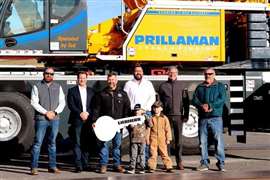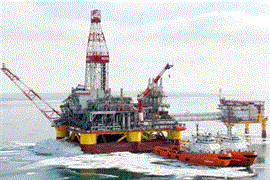Setting up shop in the USA: SC&RA news November 2019
10 December 2019

From major enterprises to small shops, every day, foreign nationals set up businesses in the USA. For most of them, accessing the country is key to growth and continued success. It’s no different for international SC&RA members, many of whom have made the leap and set up subsidiary locations, satellite offices or much more formal operations in America.

Jaime Serdan, US managing director at Group Cargo Lift landed in the country in 2019, when his Mexico-based company, which started in 2007, took advantage of timing. “In 2018 we had presidential elections and a change to a populist government that is halting economic growth, which creates new challenges for companies in Mexico,” he explained. “It seemed natural to diversify our revenue base into a new and much bigger market so, in 2019, we decided to open a new location in Dallas, Texas.”
While Cargo Lift’s business model had already proven successful in Mexico, boasting six locations, Serdan pointed out that one key factor pushed them towards the USA. “Our US partners and providers encouraged us to replicate our model in the States,” he said. “They believed if we provided the same level of service and dedication to customers here, we’d find similar success.”
Cargo Lift found that success by working hard to become the best Mexican cargo-movement company. “To achieve it, we needed to team up with the best brands in the industry, so the company managed to acquire distribution in Mexico through many established names,” said Serdan. “Another key factor was the commitment to technology that Cargo Lift understood it needed to adapt. We also created an app for smartphones and tablets where the first slings calculator for Mexico was incorporated. Additionally, we launched a website with an online store where clients could price and buy any slings or related accessories, and acquired the exclusive representation of Automated ID in Mexico, so that all our manufacturing products have a unique code or cloud-based CHIP RFID for traceability and frequent inspections according to the ASME standard.”
Such innovation has allowed Cargo Lift to become the second-largest rigging company in Mexico, expanding throughout the construction, marine, oil & gas and shipping industries, and beyond.
While landing in the USA wasn’t particularly challenging for Serdan and Cargo Lift, the main hurdle, he indicated, is brand recognition. “Promotion and getting people to trust in our products and services is the focus. We want to grow quickly, but that doesn’t mean we need to rush and make decisions that would cost money. The company is investing with its own resources without the support of a big company or financing from a bank, so we have to be very cautious on how we spend our money and pursue growth intelligently. We are replicating the model that was successful in Mexico, and hope to experience the same level of growth here in the US.”
Currently operating as the first Cargo Lift employee working in the USA, out of a small office with no warehouse, Serdan is assembling a capable team, setting strategic direction, working to launch a robust online sales store and positioning the launch of the their first facility, in North Dallas, where they’ll enjoy space to both manufacture and stock their product line.
“We’ve been planning this for a long time, and it’s all finally coming together,” he confirmed. “Our next big step will be bringing the new facility and equipment and people it requires. Seeing the entrance to the building with the Cargo Lift USA logo will be a moment of great satisfaction.”
Power of partnerships
Stefan Kohler, vice president of sales at Goldhofer can relate. Goldhofer officially landed in the USA in Miramar, Florida, in 2017. An SC&RA member since 1972, Goldhofer has been providing the industry with its innovative product line for nearly 60 years. The decision to land in Florida, Goldhofer’s first location outside Germany was, ultimately, an easy one.

“We took over our long-term service partner, Flite Line Equipment,” said Kohler. “Two years ago, we had the opportunity to buy them out and it was a perfect fit for us and that’s why we’re here.”
One of the biggest challenges for Kohler in landing in the USA was his work visa. “I never really thought about that procedure – that it would take that long,” he noted, “but it took about seven months to get it all done. Something I’d recommend to other SC&RA members who are looking to come to the US similarly – always get professional support from a dedicated attorney who knows exactly what to do as far as the immigration and visa procedures.”

Sarah Spivey, managing director at UK-headquartered Modulift, has been doing business in the USA for many years, though the company doesn’t operate out of a physical location. Her recommendation to SC&RA member companies looking to land or do business there is simple. “Work hard, build strong relationships and commit to the partnerships.”
The only hurdle that springs to mind for Spivey involved cultivating success. “To ensure the success of our partners, we always commit to an intensive training schedule – training in-house with our partners on the technical and sales aspects of the products and also spending time on the road with the external sales people,” she added.
“We decided when we began the company that working closely with partners around the world was the way we wished to grow our business,” Spivey maintained. “Each partner knows their market far better than we could ever do and has much greater opportunities to grow relationships with customers.”
Delivering on promises
“My advice to anyone wanting to set up in the US is, firstly, be patient – don’t run before you can walk,” urged Peter Hird, co-founder and joint managing director at UK-based Blokcam.

While Hird knows that the UK and North America trade freely with each other and have a similar approach to safety, he also recognises some challenges. “I’m not afraid to politely say that some of the safety standards and acceptance to change are lagging a good few years behind the UK and EU safety standard in crane operations – and this offered some challenging times in the beginning of our US campaign.”
Blokcam, which launched its first crane camera product internationally in late 2015, and then in the USA via the SC&RA’s Annual Conference and Crane & Rigging Workshop in 2016 – knew that the size of the USA would also be a challenge.
“So we engaged with several US distributors to sell and support our products,” said Hird. “General market acceptance to change was a major stumbling block – some of the US insurance and risk-management brokers had already denounced the use of cameras, as they felt it would incriminate crane operators and crane rental owners. So, we embarked on a direct educational process. One of Blokcam’s unique selling propositions is that the founders originate from the crane industry, and this reflects in the product. We can talk cranes – we know how to work with cranes – and having this synergy allows us to sell our knowledge to the customers.”
Ultimately, Hird has used this knowledge to grow Blokcam in the USA – acquiring key insights along the way. “Engage with your industry associations and network with these people; by doing this, you will slowly be accepted and build up a great relationship personally with your potential customers. From here on in, it’s much easier to get to your clients and deliver your promises.



